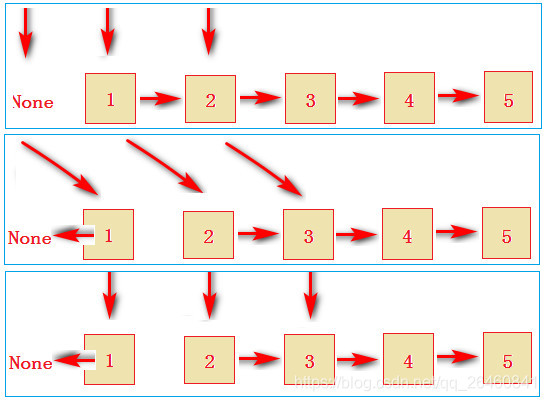title: leetcode-206 | 反转链表
date: 2019-5-3 17:37:38
comments: true
categories: “leetcode”
tags:
- leetcode 简单难度
- 链表
题目描述
反转一个单链表。
示例:
输入: 1->2->3->4->5->NULL
输出: 5->4->3->2->1->NULL
进阶:
你可以迭代或递归地反转链表。你能否用两种方法解决这道题?
解答思路
思想来源于数据结构中的链表的翻转。
翻译如下:
# Definition for singly-linked list.
# class ListNode(object):
# def __init__(self, x):
# self.val = x
# self.next = None
class Solution(object):
def reverseList(self, head):
"""
:type head: ListNode
:rtype: ListNode
"""
if head==None or head.next==None:
return head
#加入一个虚拟头节点,方便操作
virtual = ListNode(0)
virtual.next = None
p = head
q = head.next
while q:
p.next = virtual.next
virtual.next = p
p = q
q = q.next
#最后一个位置,也就是q,赋值后的p,还没有完成赋值,需要退出循环后再重复一次
p.next = virtual.next
virtual.next = p
return virtual.next
结果:
执行用时 : 44 ms, 在Reverse Linked List的Python提交中击败了36.40% 的用户
内存消耗 : 13.6 MB, 在Reverse Linked List的Python提交中击败了44.93% 的用户
| 提交时间 | 状态 | 执行用时 | 内存消耗 | 语言 |
| 几秒前 | 通过 | 44 ms | 13.6MB | python |
很老土的解法
遍历获取数据,翻转,构成数据格式
# Definition for singly-linked list.
# class ListNode(object):
# def __init__(self, x):
# self.val = x
# self.next = None
class Solution(object):
def reverseList(self, head):
"""
:type head: ListNode
:rtype: ListNode
"""
if head==None or head.next==None:
return head
#可以把数据全部整下来,在反转,在构成
li = []
p = head
while p:
li.append(p.val)
p=p.next
li.reverse()
head = ListNode(li[0])
p = head
for i in range(1,len(li)):
s = ListNode(li[i])
p.next = s
p=p.next
p.next = None
return head
结果:
执行用时 : 44 ms, 在Reverse Linked List的Python提交中击败了36.40% 的用户
内存消耗 : 15.7 MB, 在Reverse Linked List的Python提交中击败了16.62% 的用户
| 提交时间 | 状态 | 执行用时 | 内存消耗 | 语言 |
| 几秒前 | 通过 | 44 ms | 15.7MB | python |
我们使用指针(推荐)
图解:

# Definition for singly-linked list.
# class ListNode(object):
# def __init__(self, x):
# self.val = x
# self.next = None
class Solution(object):
def reverseList(self, head):
"""
:type head: ListNode
:rtype: ListNode
"""
if head==None or head.next==None:
return head
pre = None
cur = head
while cur:
#由于如果cur为None的时候,是没有next的,所以我们将它放置到了循环中,判断非None生效,故而在这里声明我们的饿next指针
next = cur.next
#我们的移动逻辑
cur.next = pre
pre = cur
cur = next
return pre #cur一定是None
结果:
执行用时 : 36 ms, 在Reverse Linked List的Python提交中击败了100.00% 的用户
内存消耗 : 13.3 MB, 在Reverse Linked List的Python提交中击败了50.21% 的用户
| 提交时间 | 状态 | 执行用时 | 内存消耗 | 语言 |
| 几秒前 | 通过 | 36 ms | 13.3MB | python |
分析:
如果用两个指针,如下图,是不好操作的。

